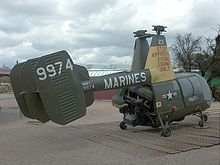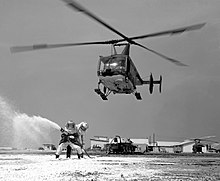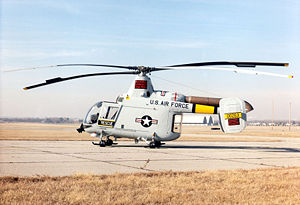


HOK/HUK/H-43 (Kaman K-600) Huskie Helicopter
The Kaman HH-43 Huskie was a helicopter with intermeshing rotors used by the United States Air Force, the United States Navy and the United States Marine Corps from the 1950s until the 1970s. It was primarily used for aircraft firefighting and rescue in the close vicinity of air bases, but was later used as a short range overland search and rescue aircraft during the Vietnam War.
Under the aircraft designation system used by the U.S. Navy pre-1962, Navy and U.S. Marine Corps versions were originally designated as the HTK, HOK or HUK, for their use as training, observation or utility aircraft, respectively.
In 1947 Anton Flettner, a German aviation engineer, was brought to New York in the United States as part of Operation Paperclip.[1] He was the developer of Germany’s Flettner Fl 282 “Kolibri” (Hummingbird), a helicopter employing the “synchropter” principle of intermeshing rotors, a unique design principle that dispenses with the need for a tail rotor. Flettner settled in the United States and became the chief designer of the Kaman company, where he started to design new helicopters, using the synchropter principle.
The Huskie had an unusual intermeshing contra-rotating twin-rotor arrangement with control effected by servo-flaps. The first prototype flew in 1947 and was adopted by the U.S. Navy with a piston engine. In 1954, in an experiment by Kaman and the U.S. Navy, one HTK-1 was modified and flew with its piston engine replaced by two turbine engines, becoming the world’s first twin-turbine helicopter.[2] The Air Force later adopted a version with one turboshaft engine: HH-43B and F versions.
This aircraft saw use in the Vietnam War with several detachments of the Pacific Air Rescue Center, the 33d, 36th, 37th, and 38th Air Rescue Squadrons, and the 40th Aerospace Rescue and Recovery Squadron, where the aircraft was known by its call sign moniker “Pedro”. During the war, the two-pilot HH-43 Huskie flew more rescue missions than all other aircraft combined, because of its unique hovering capability. The HH-43 was eventually replaced by newer aircraft in the early 1970s.
XHTK-1
two two-seat aircraft for evaluation
HTK-1
three-seat production version for the United States Navy, later became TH-43E, 29 built
XHTK-1G
one example for evaluation by the United States Coast Guard
HTK-1K
one example for static tests as a drone
XHOK-1
prototype of United States Marine Corps version, two built
HOK-1
United States Marine Corps version powered by a 600 hp R-1340-48 Wasp radial piston engine; later became OH-43D, 81 built
HUK-1
United States Navy version of the HOK-1 with R-1340-52 radial piston engine; later became UH-43C, 24 built
H-43A
USAF version of the HOK-1; later became the HH-43A, 18 built
HH-43A
post-1962 designation of the H-43A
H-43B
H-43A powered by an 860 shp Lycoming T-53-L-1B turboshaft engine, three-seats and full rescue equipment; later became HH-43B, 200-built
HH-43B
post-1962 designation of the H-43B
UH-43C
post-1962 designation of the HUK-1
OH-43D
post-1962 designation of the HOK-1
TH-43E
post-1962 designation of the HTK-1
HH-43F
HH-43B powered by an 825 shp T-53-L-11A turboshaft engine with reduced diameter rotors, 42 built and conversions from HH-43B
QH-43G
One OH-43D converted to drone configuration
